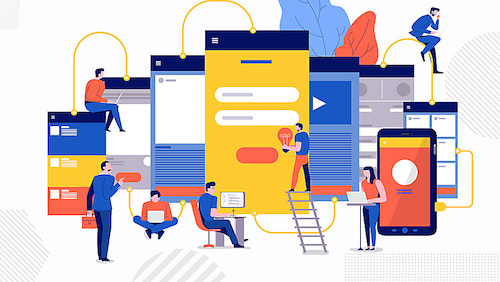The job of the UX Designer is to improve the user experience, make it pleasant and useful. For this, he applies an approach centered on the user experience: UX Design. The role of the UX designer is to intervene throughout the interface design process, by testing at each stage. He is interested in ergonomics and usability, but even more in the quality of the experience in all its dimensions. In summary, the UX Designer takes into account the needs of the user and translates them into the interface.
UX Design can be defined as a design centered on the user experience. From an etymological point of view, UX is “User eXperience”. “Design” comes from the Latin word “designare”, which means “to mark with a sign, to draw, to indicate”. In English, to design therefore means both drawing and designing according to a plan, an intention, a purpose.
UX/UI Design aims to improve, simplify, optimize the experience of a service or product and solve any problems related to its use. We often hear, in everyday language, that the user experience must be “more ergonomic”, “more intuitive”. It is a formulation that aims to qualify the nature of the desired experience. UX/UI Design is not limited to making the interface “functional”. This design method goes much further by accompanying the experience in its emotional dimension (emotional design).
The UX/UI Designer’s task is to design an interface that anticipates user expectations while meeting their needs. In this, he has a strategic role in interface design. A UX/UI designer must be rigorous and place the user experience at the center of his analyzes and proposals. Its main objective is to understand the user and try to ensure an optimal experience.
When it comes to understand the relationship between UI and UX, it is worth understanding that a UX Designer is in charge of improving the user experience, while a UI Designer focuses on the visual dimension of the interface (User Interface). Where the first implements many design and test methods, the second designs the graphic design of the interface. As these tasks are closely related, it is common for designers to be both at the same time.
It is worth noting that there are many types of UX designer: Lead UX, Interaction Designer, Service Designer etc. Although each of these specializations have its own purpose, they all apply the fundamentals of cognitive science and cognitive psychology.
All the skills acquired by a UX/UI designer must be enriched with feedback from end users. A UX designer with extensive experience knows how important it is to know how to remain humble and rigorous in the application of methods. Assuming that the current project resembles a previous project would be a serious mistake.
A UX/UI Designer has a wide range of methods that he deploys in an iterative design cycle, such as ethnography, user studies (UX Research), ideation, co-design workshops, modeling and prototyping, user testing etc. This list is far from being exhaustive. As each project is different, a UX/UI Designer adjusts the methods and tools as needed. He must take into account the company context and the project limitations (budgetary, specificities, temporality, etc.). His role is to involve the various stakeholders in a collaborative, iterative and user-centric approach. In this, he is a mediator and an ambassador of this user-centered design approach to organizations.

UX Research provides the UX/UI Designer with various means to explore and collect the information he will need. UX research is not an option. It is a knowledge base that must be solid enough to draw from it the resources that will make the difference when it comes to proposing creative solutions.
A UX/UI Designer involves the user in the design phase. User testing is a good illustration of this, the best known and the most visible, but each UX method invites the end user into the design process in its own way, and there are plenty of them! The UX Designer must therefore determine which UX method is relevant for each design stage. This will depend on the project’s resources and constraints: time, budget, technical environment, etc., but also sometimes on the affinities he has with determined methods.
A “good” UX/UI Designer must show empathy, but not in the common sense of this term – it is not about feelings. He must be able to deeply listen to user´s needs and expectations. A UX/UI Designer can therefore never “put himself in the user´s shoes” as we sometimes hear. He must have the humility to conduct user studies and ultimately trust user tests, regardless of his personal opinion on the expected uses.
Regarding UX user testing, its goal is to ensure trust and credibility. In other words, these tests are useful to simplify usage and improve accessibility, but also to ensure user trust and therefore guarantee the credibility of the product or service.

